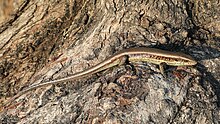Eutropis macularia
| Eutropis macularia | |
|---|---|

| |
| on a tree trunk, in Laos | |
| Scientific classification | |
| Domain: | Eukaryota |
| Kingdom: | Animalia |
| Phylum: | Chordata |
| Class: | Reptilia |
| Order: | Squamata |
| Family: | Scincidae |
| Genus: | Eutropis |
| Species: | E. macularia
|
| Binomial name | |
| Eutropis macularia (Blyth, 1853)
| |
| Synonyms | |
|
Mabuya macularia (Blyth, 1853) | |
The bronze grass skink or bronze mabuya (Eutropis macularia) is a species of skink found in South and Southeast Asia.[1]
Description
Physical structure: Body cylindrical, dorsal scales with 5-8 keels, ventral scales smooth; 28-30 scales round the body. A pair of dorso-lateral bands starts from above the eye till the base of the tail. As with other Eutropis species the scales are keeled.[2]
Color pattern: Deep-brown, olive or bronze-brown in color; dorso-lateral bands light or yellow; sometimes with black spots on the base of the tail. Breeding males have orange color on the lateral side of the body. Juveniles are grey with a bronze head.[2]
Length: Maximum: 23 cm, common: 16 cm (SVL 7 cm).[3]
Distribution
This skink is found in Bangladesh, Bhutan, Cambodia, India, Laos, Malaysia (northwestern), Myanmar, Nepal, Pakistan, Sri Lanka, Thailand and Vietnam. Type locality is Rangpur, Bengal [Bangladesh].[1]
Impact on humans and ecology
No known human uses. Plays a role in ecosystem by eating various types of insects and otherwise.[citation needed]
Threat to humans
Non-venomous and harmless to humans. May bite when handled, but is not dangerous.[citation needed]
IUCN threat status
Not Evaluated (NE).[citation needed]
Tail regeneration
Can break off its own tail when grabbed by predators; the tail regenerative and will grow back over time.[citation needed]
Gallery
-
Eutropis macularia eating a frog in Laos
-
Bronze Grass Skink
References
- ^ a b Eutropis macularia at the Reptarium.cz Reptile Database. Accessed 19 July 2014.
- ^ a b "Eutropis macularia (Blyth, 1853)". Reptiles of Madhya Pradesh. Snake Research Organization Ujjain. 2014. Retrieved 12 October 2015.
- ^ "Speckled Forest Skink". Ecology Asia. 2015. Retrieved 12 October 2015.
Further reading
- Annandale, N. 1909 Rec. Ind. Mus. 3: 257
- Blanford, W.T. 1879 Notes on a collection of reptiles and frogs from the neighbourhood of Ellore and Dumagudem. J. Asiat. Soc. Bengal xlviii: 109-116
- Blyth, E. 1854 Notices and descriptions of various reptiles, new or little-known. Part I. J. Asiat. Soc. Bengal 22 [1853]: 639-655
- Das I. 1991 A new species of Mabuya from Tamil Nadu State, Southern India (Squamata: Scincidae). Journal of Herpetology 25 (3): 342-344.
- Mausfeld, P.; Vences, M. Schmitz, A. & Veith, M. 2000 First data on the molecular phylogeography of scincid lizards of the genus Mabuya. Mol. Phylogenet. Evol. 17 (1): 11-14



